9 Books Published by Inner Traditions on AALBC — Book Cover Collage
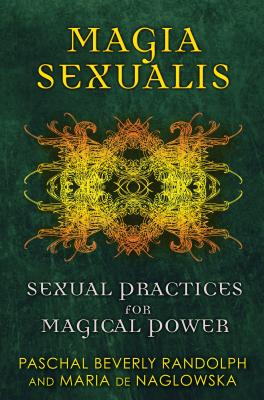 Magia Sexualis: Sexual Practices for Magical Power
Magia Sexualis: Sexual Practices for Magical Power
by Paschal Beverly RandolphInner Traditions (Aug 27, 2012)
Read Detailed Book Description
A step-by-step guide to the occult science of sex magic
- Based on the practices of P. B. Randolph, occult rival of H. P. Blavatsky
- Reveals how to perform sex magic rituals for specific real-world results, such as greater strength or enhancement of the senses
- Explains how to create magical talismans, such as rings with specific planetary forces, how to enliven a painting, and how to charge an effigy
Conceived by Paschal Beverly Randolph, Magia Sexualis has been heralded as the most influential book about sex magic ever written, surviving to the present day solely through Maria de Naglowska’s French translation. Published more than 50 years after Randolph’s death, the authorship of this “translation” has been repeatedly called into question: while the greater part of the content can be traced to Randolph’s known works, a very significant portion cannot—leading to the conclusion that this work was supplemented by Naglowska’s own sex magic practice and extensive occult teachings.
Magia Sexualis explains Randolph’s meticulous science of sex magic, practiced by the Brotherhood of Eulis and the Hermetic Brotherhood of Light. Beginning with exercises to develop essential skills, the book explains in step-by-step detail how to perform sex magic rituals for specific results, such as greater strength or enhancement of the senses; how to charge and use a “volt”—an effigy of a specific person you want to influence or protect; how to enliven a painting in order to influence those around it; and how to create magical talismans with specific planetary forces, using what Randolph calls “fluid condensers.”
This work from two great occult minds shows that the true power of the spirit is acquired in conjunction with the power of sex—affirming that “sex is the fundamental force in every being, the most powerful force in Nature, and the most characteristic evidence of God.”
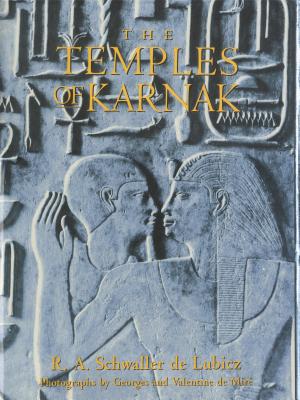 The Temples of Karnak
The Temples of Karnak
by R. A. Schwaller de LubiczInner Traditions (Oct 01, 1999)
Read Detailed Book Description
More than 700 photographs and line illustrations documenting the ancient Egyptian temples of Karnak
• A magnificent excursion that explores the monuments, ruins, statues, and bas-reliefs from the ancient and highly developed civilization of Egypt
• The only complete photographic record available of this important acheological treasure
• Contains 600 photographs by two top French award-winning photographers
This book is a magnificent excursion led by R. A. Schwaller de Lubicz to the monuments, ruins, statues, and bas-reliefs of the temples of Karnak. With nearly 600 photographs by Georges and Valentine de Mire, more than 450 of which are full-page plates, this volume is the only complete photographic record of this important historic site. Because of recent vandalism many of the artifacts are no longer intact, and it is no longer possible to see many of the details captured in these images.
This promenade through the temples of Karnak reveals the remains of a world devoted to an unimpeachable faith in the afterlife, a faith whose conviction seems to have exalted its builders and artists, as was the case for several brief centuries with those who constructed the cathedrals of the Middle Ages. One did not work at fashioning these stones, nor were these works sculpted under someone’s strict authority; here it was necessary to act out of the heart. Every gesture in the depictions, every arrangement in the buildings, is a hieroglyph from the symbolic language of the sages who spoke to spirit and consciousness.
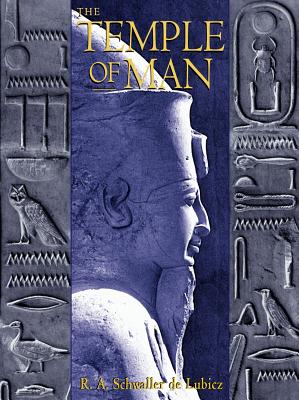 The Temple of Man
The Temple of Man
by R. A. Schwaller de LubiczInner Traditions (Nov 01, 1998)
Read Detailed Book Description
The monumental Temple of Man represents the most important breakthrough in our understanding of Ancient Egypt since the discovery of the Rosetta stone. This exhaustive and authoritative study reveals the depths of the mathematical, medical, and metaphysical sophistication of Ancient Egypt. Schwaller de Lubicz’s stone-by-stone survey of the temple of Amun-Mut-Khonsu at Luxor allows us to step into the mentality of Ancient Egypt and experience the Egyptian way of thinking within the context of their own worldview.
His study finds the temple to be an eloquent expression and summary—an architectural encyclopedia—of what the Egyptians knew of humanity and the universe. Through a reading of the temple’s measures and proportions, its axes and orientations, and the symbolism and placement of its bas-reliefs, along with the accompanying studies of related medical and mathematical papyri, Schwaller de Lubicz demonstrates how advanced the civilization of Ancient Egypt was, a civilization that possessed exalted knowledge and achievements both materially and spiritually. In so doing, Schwaller de Lubicz effectively demonstrates that Ancient Egypt, not Greece, is at the base of Western science, civilization, and culture.
To understand the temple of Luxor, twelve years of field work were undertaken with the utmost exactitude by Schwaller de Lubicz in collaboration with French archaeologist Clement Robichon and the respected Egyptologist Alexandre Varille. From this work were produced over 1000 pages of text and proofs of the sacred geometry of the temple and 400 illustrations and photographs that make up The Temple of Man.
The Temple of Man is a monument to inspired insight, conscientious scholarship, and exacting archaeological groundwork that represents a major contribution to humanity’s perennial search for self-knowledge and the prehistoric origins of its culture and science.
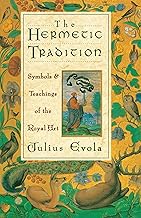 The Hermetic Tradition: Symbols and Teachings of the Royal Art
The Hermetic Tradition: Symbols and Teachings of the Royal Art
by Julius EvolaInner Traditions (Jan 01, 1995)
Read Detailed Book Description
This important survey of alchemical symbols and doctrines sets forth the mysterious worldview and teachings of the practitioners of the “royal art.” One of the leading exponents of the Hermetic tradition, Julius Evola demonstrates the singularity of subject matter that lies behind the words of all adepts in all ages, showing how alchemy—often misunderstood as primitive chemistry or a mere template for the Jungian process of “individuation”—is nothing less than a universal secret science of human and natural transformation.
First published in 1931 in Italian. This is the first English translation.
Draws from a host of sources in the Western esoteric tradition—works on theurgy, magic, and gnosticism from neoplatonic, Arab, and medieval sources.
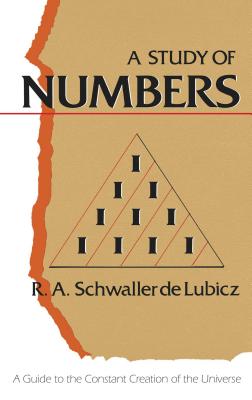 A Study of Numbers: A Guide to the Constant Creation of the Universe
A Study of Numbers: A Guide to the Constant Creation of the Universe
by R. A. Schwaller de LubiczInner Traditions (Oct 01, 1986)
Read Detailed Book Description
We lack direct consciousness of Space and Time. We can know of them only indirectly by mass, force, and energy, and by the intermediary of phenomena such as may be tested by our five senses. Without direct awareness of Space or Time, human beings lack two “senses” necessary for the knowledge of all causes. From this imperfection, of which we are always being made aware, is born our need to simplify. Thus we reduce everything to fundamental properties, without paying any attention to the underlying universal organization, the effects of which are all around us.
The result is that the science of numbers, the most wonderful guide to the constant creation of the universe, remains an enormous hypothesis so long as its use has not awakened in us the higher consciousness of a universal order. By deepened knowledge of things and their process of becoming, we must come to recognize Numbers as a truth, and to experience with our senses the living relation of a cause to an effect, this relation being truer and more real than the effect could ever be.
Published in 1917 under the author’s given name of René Schwaller, A Study of Numbers is the first expression of the teachings we have come to associate with his later and better known name, R.A. Schwaller de Lubicz. It is a masterly account of the living, universal, qualitative, and casual reality of numbers.
Starting from the irreducible one, Schwaller deals with the unfolding of creation through the cycles of polarization, ideation, and formation. Topics covered include: numbers, values, and relations; the disengagement of numbers; the harmonic basis of numbers; the development of values; and the establishment of harmony.
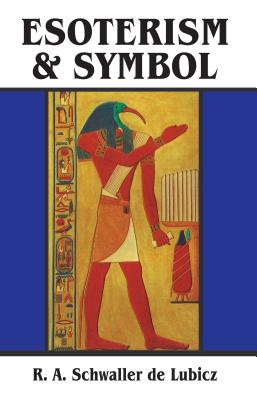 Esoterism and Symbol
Esoterism and Symbol
by R. A. Schwaller de LubiczInner Traditions (Feb 01, 1985)
Read Detailed Book Description
This is an initiation into the tone, structure, and mentality of Egyptian knowledge, the basis of all Western theology and science. It is a redefinition of those concepts which are basic to the pharaonic transmission—the glory of ancient Egypt. The author explores the "process of becoming" as related to consciousness and revealed in nature; the kinship between man and the mineral, plant and animal kingdoms; the stages of awareness leading to "Cosmic Consciousness"; and the mystery of the formation of substance into matter.
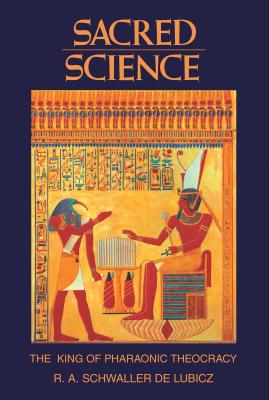 Sacred Science: The King of Pharaonic Theocracy
Sacred Science: The King of Pharaonic Theocracy
by R. A. Schwaller de LubiczInner Traditions (Apr 01, 1982)
Read Detailed Book Description
R. A. Schwaller de Lubicz (1887-1961), one of the most important Egyptologists of this century, links the sacred science of the Ancients to its rediscovery in our own time. Sacred Science represents the first major breakthrough in understanding ancient Egypt and identifies Egypt, not Greece, as the cradle of Western thought, theology, and science.
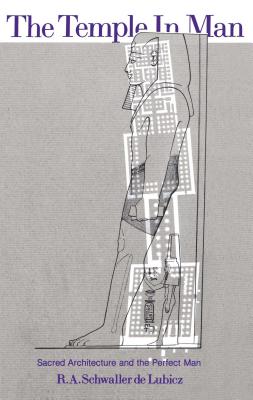 The Temple in Man: Sacred Architecture and the Perfect Man
The Temple in Man: Sacred Architecture and the Perfect Man
by R. A. Schwaller de LubiczInner Traditions (Nov 01, 1981)
Read Detailed Book Description
This book contains the first published results of Schwaller’s 12 years of research at the temple of Luxor and its implications for interpreting the symbolic and mathematical processes of the Egyptians through their sacred architecture.
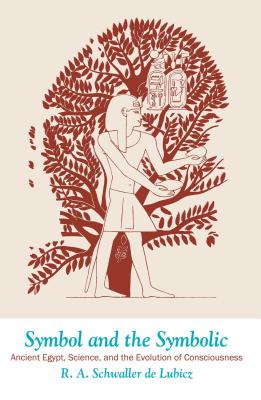 Symbol and the Symbolic: Ancient Egypt, Science, and the Evolution of Consciousness
Symbol and the Symbolic: Ancient Egypt, Science, and the Evolution of Consciousness
by R. A. Schwaller de LubiczInner Traditions (Nov 01, 1981)
Read Detailed Book Description
Symbolism is the intuitive means of overcoming the limitations of reason. Here Schwaller explains how true progress in human thought can be made only if we call upon the "symbolizing" faculty of intelligence, developed and refined in the temple culture of ancient Egypt and reflected in its hieroglyphs.
